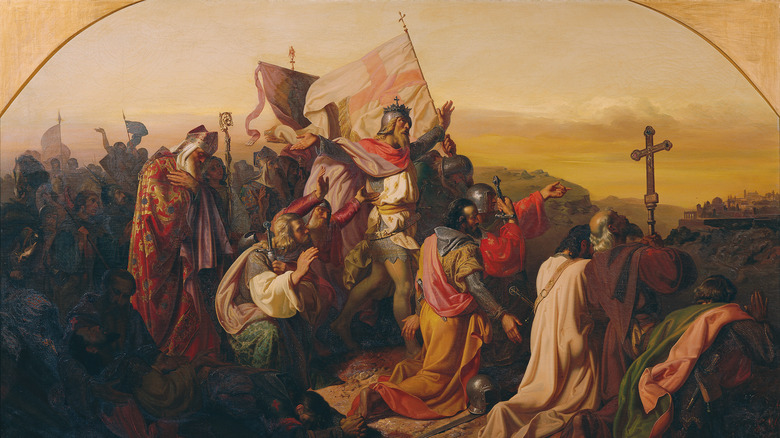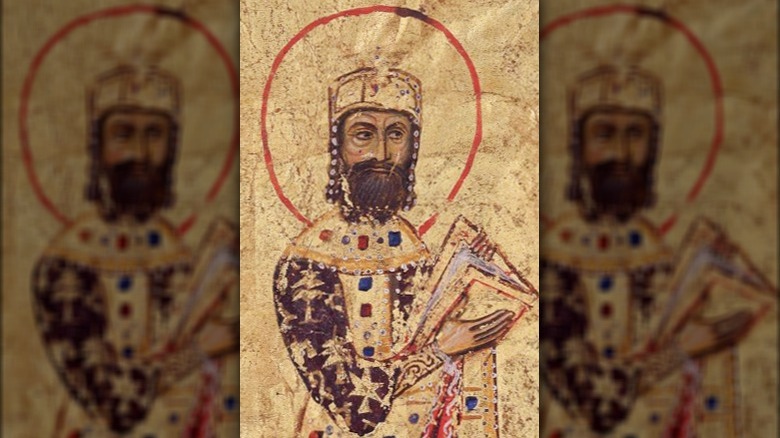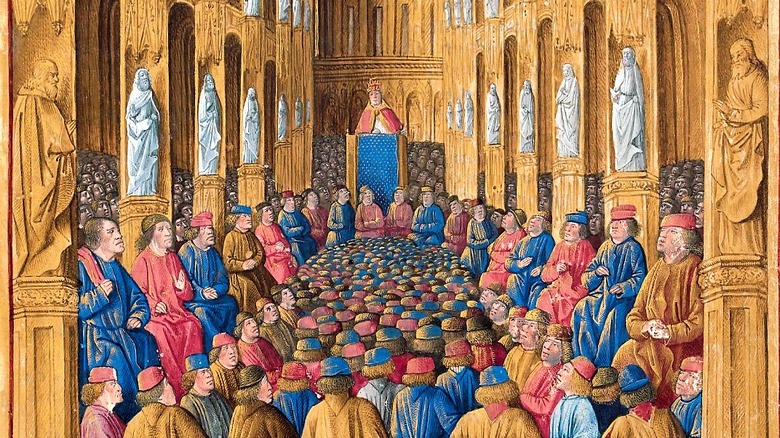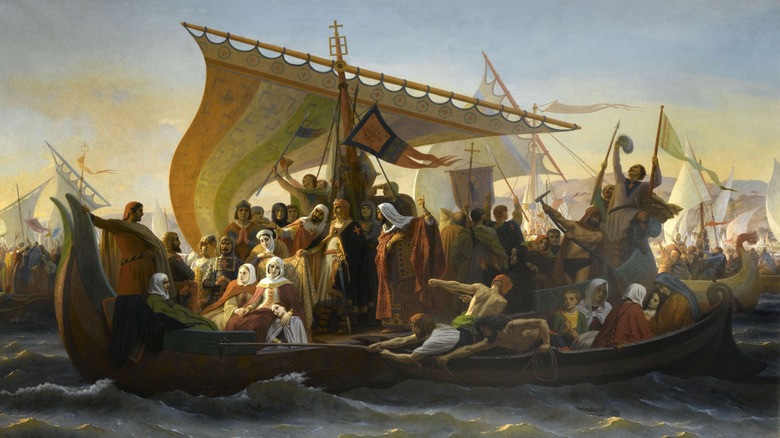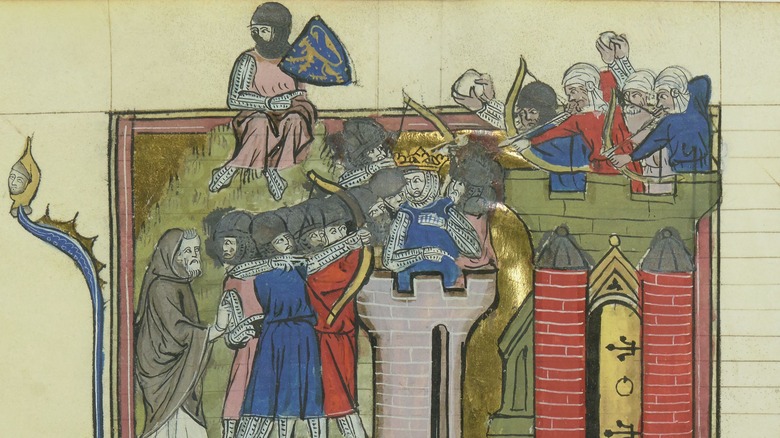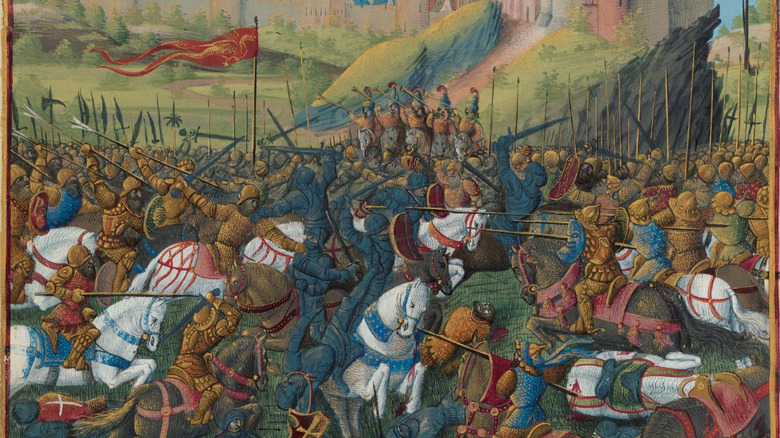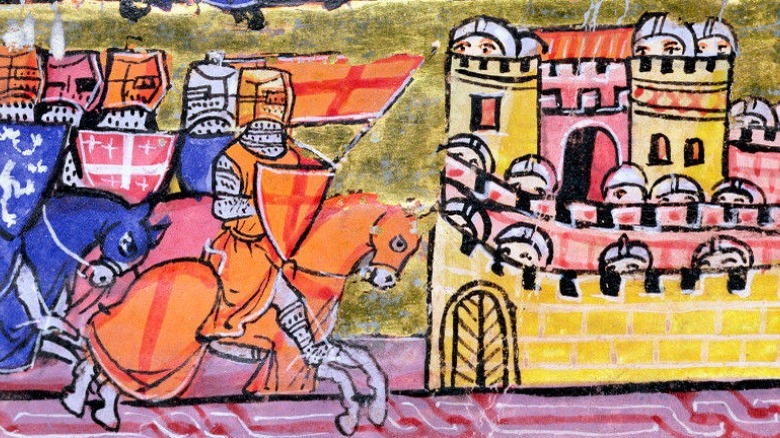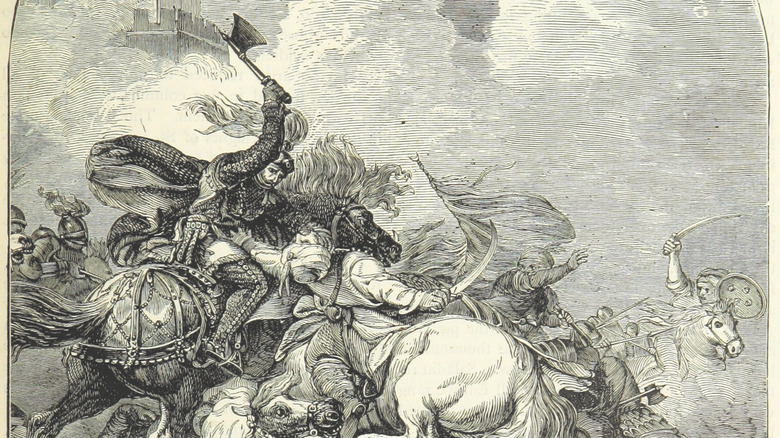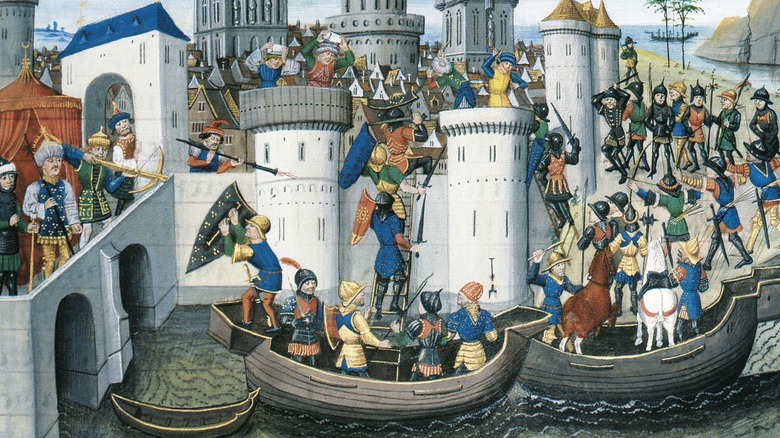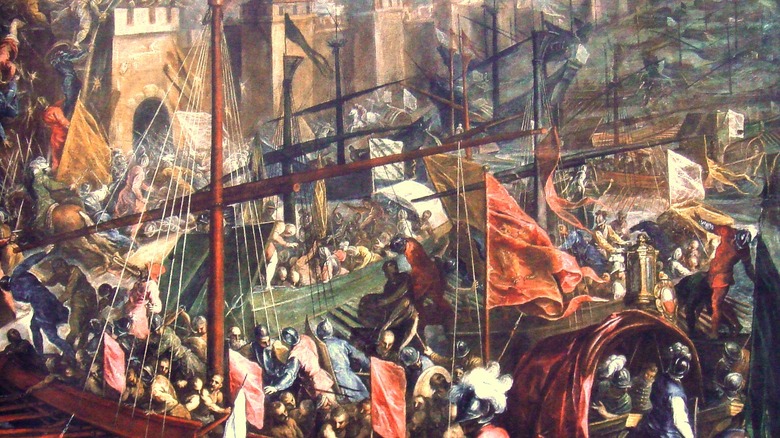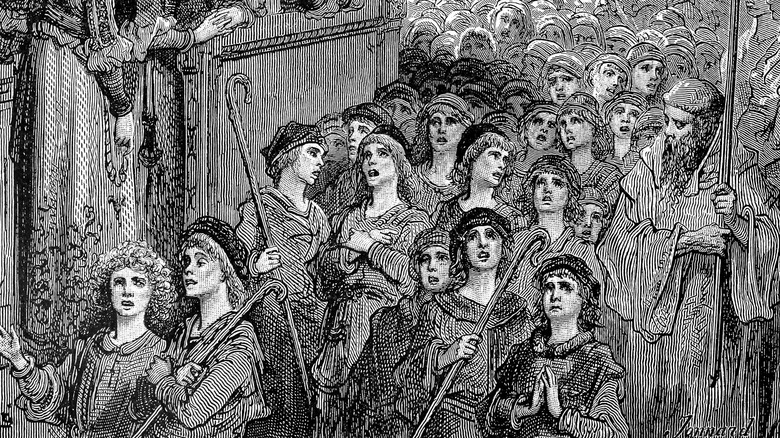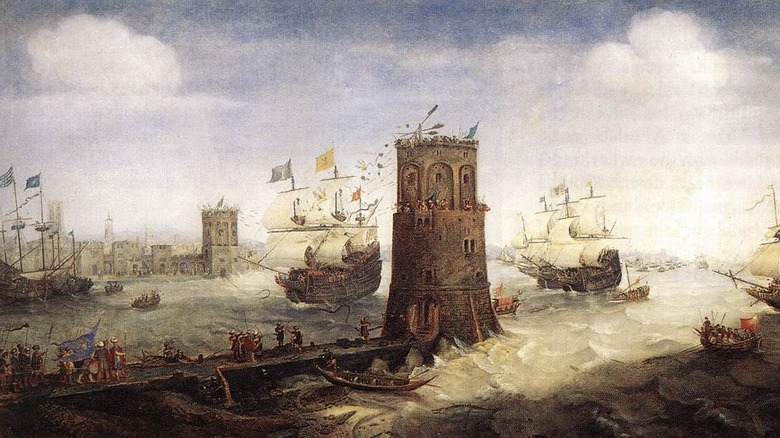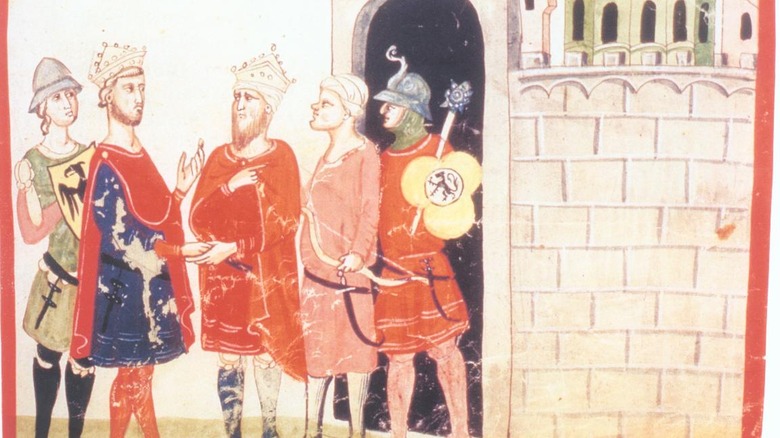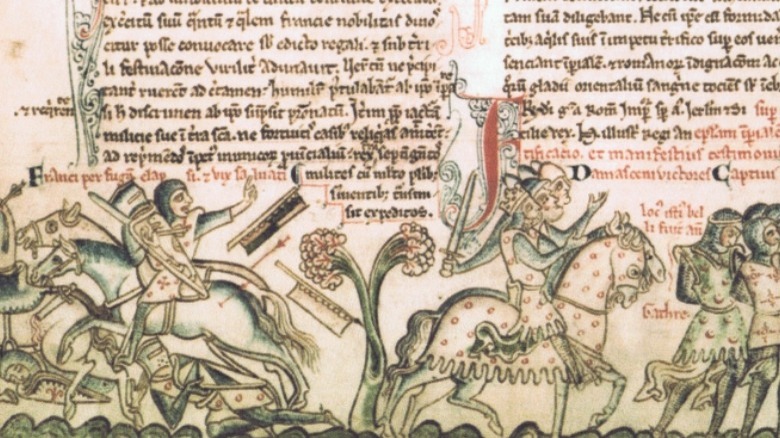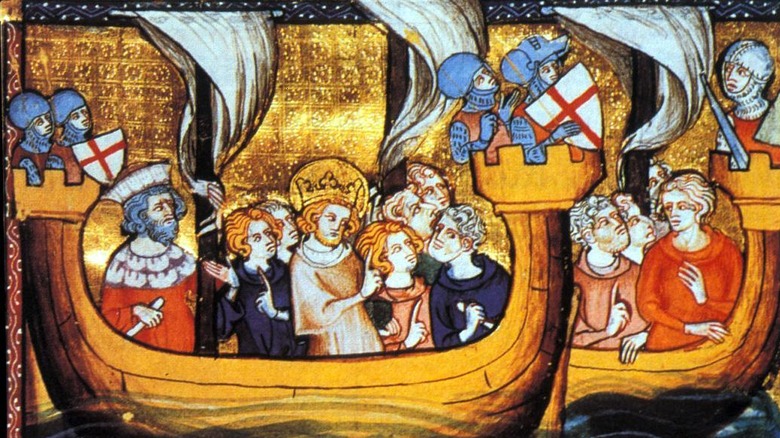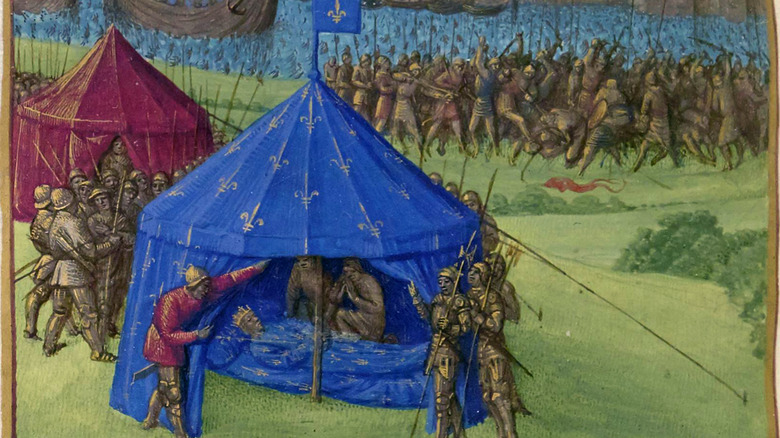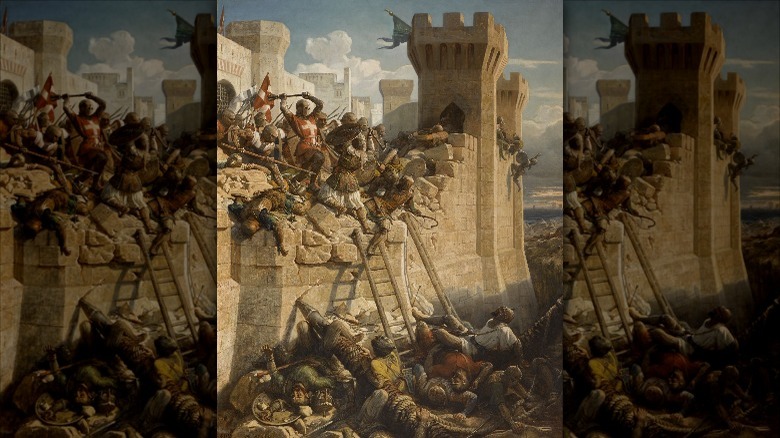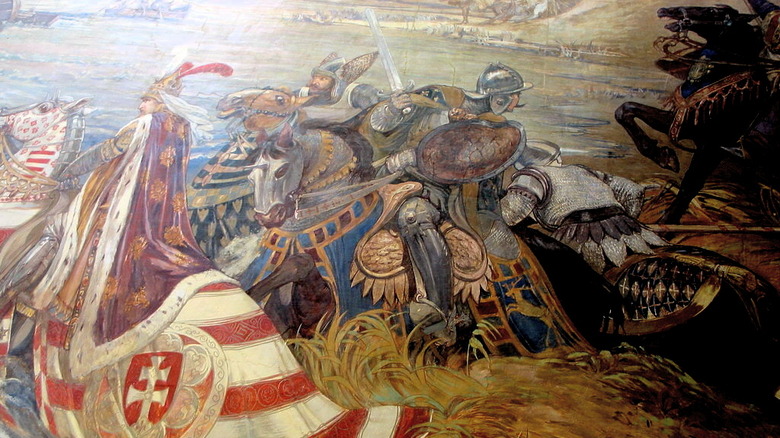The Medieval Crusades Timeline Explained
The word "crusade" has survived as an everyday word thanks in part to enduring works of popular fiction, such as "Indiana Jones and the Last Crusade" or Batman's nickname as the Caped Crusader. But in modern parlance, we typically use the word to refer to a large, organized effort toward a cause such as a crusade against drugs or books seen as obscene. In this sense, the original idea of the capital-C Crusades has been blurred by time somewhat. While many may know that the Crusades were some kind of medieval holy war that have something to do with Robin Hood, the Knights Templar, and Muslims calling Europeans infidels, many of the finer points may have been lost. What caused the Crusades? When did they happen? How long did they last? How many were there? The answers to some of these may surprise you.
To start with, as Britannica explains, the Crusades were a series of military expeditions led by the Christian kingdoms of Western Europe against the expanding Muslim empire in the Middle East and North Africa. They were particularly — but not invariably — focused on Jerusalem and the surrounding areas known as the Holy Land, which are key sites for Muslims, Jews, and Christians. These expeditions were generally given the full support of the pope and played a major role in the development of Western Europe during the medieval period, for better and for worse. Here is an introductory look at the surprisingly long timeline of the Crusades.
Setting the stage
At the time of the First Crusade at the end of the 10th century, Western Europe was beginning to emerge from the Dark Ages of cultural and economic decline in the centuries following the collapse of the Roman Empire in the West. (The Eastern Roman Empire, retroactively known as the Byzantine Empire was still present, which is going to be important in a bit.)
According to Britannica, several kingdoms were beginning to develop into more stable governments, there was a population boom that lasted for centuries, an economic revival was revitalizing things, and events like the Norman Conquest of England in 1066 showed that European kingdoms were capable of large-scale military campaigns. That said, as History points out, the emerging power of Western Europe still paled in comparison to that of the Byzantines and the Islamic Empire, which at that point stretched from India to Spain. Most significantly for our purposes, it included Jerusalem and the Holy Land.
As the World History Encyclopedia explains, one of the most consequential inciting incidents for the First Crusade was the rise of the Seljuk Turks, a Muslim group from the Central Eurasian steppes who were beginning to encroach on Byzantine territory. Through a number of significant military victories, they had captured several notable cities in the Holy Land, including Edessa, Antioch, and — by 1087 — Jerusalem. Byzantine emperor Alexios Komnenos recognized that Western Christians would be sympathetic to his plight, so he reached out to Pope Urban II in 1095.
1095: The Council of Clermont
As Britannica explains, Alexios was fortunate that by the end of the 11th century, relations between the Western and Eastern Christian Churches were on the mend, because differences between the two sides had led to the Great Schism in 1054, which saw a division between the Roman Catholic Church and the Eastern Orthodox Church that still stands today. Thanks to these improved relations, the pope warmly received Alexios' ambassadors and was fully sympathetic to their cause. Not only did Urban recognize that Seljuk possession of key Orthodox cities like Antioch and Nicaea meant that major Catholic pilgrimage sites and shrines were also under Muslim control, but he also saw cooperation between Eastern and Western Christians as a way to help further heal the divide within the Christian world.
To that end, on November 18, 1095, Pope Urban II convened the Council of Clermont. After taking care of some other church business, including ironically renewing a commitment to peace, the pope addressed the bishops who were present with an impassioned plea for military aid to their Eastern brothers so that Christendom might control the Holy Land. The response was overwhelming: the crowd began to roar "Deus le volt" ("God wills it"), and it was decreed that every soldier involved should wear a cross (from which derives the name "Crusade"). Emperor Alexios, who had likely been expecting a small band of reinforcements, would soon serve as host to an abounding and zealous fighting force from the West.
1096: The First Crusade
The religious fervor raised by Urban's plea affected more than just warrior knights. As the World History Encyclopedia explains, the first military action of the Crusades was the so-called "People's Crusade," in which a ragtag group of knights and peasants led by a preacher named Peter the Hermit crossed the Bosporus in 1096 only to be slaughtered by the Turks. Following another failed People's Crusade also inspired by Peter's preaching, the main Crusader force arrived in Constantinople later that year.
The earliest wave of holy warriors would comprise some 60,000 fighters, of which 10% were knights. Key figures of the First Crusade would include Godfrey of Bouillon, Raymond de Saint-Gilles, and Bohemund of Taranto, a Norman duke who had formerly waged war on the Byzantine. Despite their different backgrounds and lack of a common language, they all swore loyalty to Emperor Alexios and found a way to work together. Notably, no kings took part in the First Crusade.
Over the next year, the Crusader forces, combined with the Byzantine army, managed to recapture a number of cities from the Seljuks, including Nicaea and Dorylaion, but their main target was Antioch, a key Christian city, the site of a major church, and former home to Saints Peter and Paul. From late 1097 to mid-1098, the Crusaders led a siege against Antioch, during which they suffered from famine and plague. Ultimately, they were besieged by Muslim forces from the outside and lost support from the Byzantines due to miscommunication.
1099: The Kingdom of Jerusalem and the Crusader States
The Crusaders managed to capture Antioch in June 1098 when a disgruntled Seljuk commander allowed Bohemund and his forces passage over the city wall. As Britannica explains, the other Crusaders followed and managed to quickly recapture the city.
Despite some additional setbacks — including the arrival of a huge Turkish army, an argument over the validity of a purported holy relic, an epidemic that wiped out many Crusaders, and a major argument over which commander would control the newly re-captured Antioch — in 1099, a somewhat diminished Crusader force marched to Jerusalem, which at that time was under the control of the Fatimid caliphate, not the Seljuks. The Crusaders, greatly reduced in numbers and short on supplies, laid siege to Jerusalem and Godfrey's forces were able to scale the walls with siege towers. The Muslim governor surrendered the city to Raymond, and the Crusaders brutally slaughtered Jews and Muslims throughout the city. With Jerusalem now under Christian control, the Crusaders had met their goals within three years.
Once the Crusaders had secured their possession of Palestine, they wanted to ensure that Jerusalem and the other cities remained in Christian control, so they established the Crusader States, a series of European settlements in the Middle East, in Edessa, Antioch, Tripoli, and — most significantly — the Kingdom of Jerusalem. Rather than an ecclesiastical state as planned, Jerusalem became a European-style feudal kingdom. Godfrey of Bouillon was named king and Defender of the Holy Sepulcher.
1145: The Second Crusade
Following the establishment of the Crusader States, various military and religious orders such as the Knights Hospitaller (in 1113) and the Knights Templar (around 1119) were founded to protect these pilgrimage sites and the pilgrims traveling to and from them. As History explains, such military orders plus the presence of strong castles and other fortifications allowed the Crusaders to hold sway over the Levant for several decades.
However, the frontiers of the Crusader States, particularly the northernmost state of Edessa, were vulnerable to attack from the Muslims' own holy war, which began around 1130. According to the World History Encyclopedia, Edessa had been an important commercial center for the Christian presence in the area, but it was captured in 1144 by Zangi, the Muslim governor of Mosul, who slaughtered or sold into slavery any Western Christians in the city. The Christians of Edessa begged for help from the Crusader States, and in 1145 Pope Eugenius III officially declared the Second Crusade with the goal of recapturing Edessa.
But the pope only appealed to the men of Europe by asking for the protection of holy relics, promising glory, and offering forgiveness of sin in return for military service. This lack of a clear purpose caused problems within the Crusade, as the Crusaders were somewhat hazy about what their actual goals were. Despite this, successful recruitment across Europe meant the Crusader forces were even larger than the last time, with tens of thousands of Crusaders ready to march.
1148: The Siege of Damascus
Although the First Crusade had been led by dukes such as Godfrey of Bouillon, the promise of glory in the Holy Land meant that the Second Crusade would be the first to be led by kings, including Conrad III of Germany and Louis VII of France. As Britannica explains, these forces were divided somewhat, as the Germans moved east in an effort to recapture Edessa, but other nations went to fight the Muslim occupation of Spain or non-Muslim pagans in the Baltic north. Additionally, the Crusaders lacked the support of the Byzantine emperor this time and then-emperor, Manuel Komnenos, wasn't happy about another host of Crusaders amassing upon Constantinople, as he worried it would upset his diplomatic relations with the Turks.
In most respects, the Second Crusade was a failure. While the campaigns in Spain and the Baltic were largely successful, the primary goal of reasserting Western control of the Levant was not met. The Crusaders suffered humbling defeats at Dorylaion and Damascus, which fell into the hands of Zangi's successor, Nur al-Din. The disastrous siege of Damascus essentially ended the Second Crusade, with Nur al-Din shoring up his empire by capturing Antioch soon thereafter, and relations between the West and the Byzantine Empire greatly damaged. The Crusader States would greatly diminish in the decades following the Second Crusade, as Nur al-Din would take over Damascus as well, essentially surrounding the Crusaders with a unified Muslim power.
1187: The Third Crusade
As the World History Encyclopedia explains, the unified Muslim Syria under Nur al-Din posed a threat to both the Byzantines and the Crusader States, despite some military successes by Emperor Manuel between 1158 and 1176. The threat became even greater in 1168 when Nur al-Din's general Shirkuh and his nephew Saladin captured Egypt, something the Crusaders of Jerusalem had been attempting in vain for some time.
Following Shirkuh's death, Saladin took control. As the Sultan of Egypt and Syria, he began a series of conquests in 1174 in Damasus and Aleppo before a shocking victory over the Kingdom of Jerusalem at the Battle of Hattin in 1187. Following this victory, Saladin claimed numerous Crusader possessions including Acre, Caesarea, and Jerusalem itself. In October 1187, the short-lived Pope Gregory VIII called for a Third Crusade to take back Jerusalem and recover its holy relics.
Three kings accepted the pope's call: Frederick Barbarossa of the Holy Roman Empire, Philip II of France, and Richard I of England. (You know, the Lion-Hearted from Robin Hood.) Despite the presence of the three most powerful men of Western Europe, the Crusaders failed to reconquer Jerusalem. Frederick drowned on the way to Syria, and, while Richard managed victories at Acre and Arsuf, he knew he couldn't successfully besiege Jerusalem and negotiated peace with Saladin in 1192. The Kingdom of Jerusalem was reduced to a small area of land in Acre that didn't include the city itself, which became known as the Second Kingdom.
1202: The Fourth Crusade
However you may feel about the sincerity of the religious zeal of the earlier Crusaders, there is no denying that the Fourth Crusade was a grab for money and power on the part of essentially every party involved. While the previous Crusades had been incited by specific events of conquest, Britannica explains that Pope Innocent III just kind of wanted to do one, with the somewhat vague goal of retaking Jerusalem for Christendom.
His vision was supported by a number of French nobles — and the Italian marquis Boniface of Montferrat — and an agreement was drawn up with the city of Venice to provide transport. However, Boniface was less interested in recapturing Jerusalem than in using the Crusade to stage a coup against the Byzantine capital of Constantinople — which, quick reminder, was the greatest and most powerful Christian city in the world at that time — in order to depose Emperor Alexios III and place his preferred ruler (confusingly also named Alexios) on the throne. The pope refused to use his Crusade for this purpose, but Boniface and the others didn't really care.
The Crusaders arrived in Venice in 1202 only to find that their forces were smaller than expected and they couldn't afford to pay for the large fleet the Venetians had prepared. The elderly Doge of Venice said he had an idea to settle the Crusaders' debt.
1203: The sack of Constantinople
Per Britannica, Doge Enrico Dandalo said the Crusaders could pay off what they owed for the fleet if on their way to Constantinople they first conquered the (notably, Christian) city of Zadar, which had recently defected from Italian control to the Kingdom of Hungary. As the World History Encyclopedia says, when Pope Innocent heard that the Crusaders had sacked Zadar in 1202 against his express forbiddance, he excommunicated both the Crusaders and the Venetians (though he soon forgave the Crusaders, as he obviously needed them for his Crusade).
Despite the pope's initial opposition to the diversion to Constantinople, he changed his tune when — as Britannica explains — a messenger from Prince Alexios promised that as emperor, he would unite the Eastern and Western Churches under the control of the pope once and for all, and commit Byzantine soldiers to lead the Crusaders on to conquer Egypt after they retook Jerusalem. The promise of riches that would come from sacking the wealthy imperial seat and the opportunity for revenge against the (what were perceived as) treacherous Byzantines would have been very enticing for the Western Crusaders as well.
So in June 1203, the Crusader forces arrived in Constantinople and began a siege that caught Alexios III completely by surprise, causing him to flee the city. The Crusaders smashed through the walls, looted the great city, slaughtered some 400,000 people, and returned to Europe with coffers full of loot, without moving on to Jerusalem.
1212: The Children's Crusade
While the term Crusades applies mainly to the series of Western European expeditions against Muslims in the Holy Land and adjacent areas, one Crusade against a religion other than Islam was the so-called Albigensian Crusade, which ran off and on from 1209 to 1229. As the World History Encyclopedia explains, this Crusade — also known as the Cathars' Crusade — was the first to (officially) target, not Muslims or pagans, but heretical Christians in Languedoc in Southern France.
The Cathars, also known as the Albigensians, were a group who believed that Satan had created the physical world and that Jesus had never appeared in the material world. Their popularity began to pose a threat to the Catholic Church in the region, but the real motivation for this crusade was likely the annexation of the region by the Kingdom of France. Over the course of 20 years, campaigns were launched sporadically against the Cathars. This Crusade failed to suppress the cult but did manage to annex Languedoc.
Even more tragic was the Children's Crusade of 1212, which, per History, saw a 12-year-old from France pursue his alleged divine vision that told him to take 30,000 unarmed children and teens to try to capture the Holy Land through the power of spirited debate. It's unclear what happened to the children crusaders, but they certainly never made it to the Holy Land. Many, it seems, were drowned or sold into slavery. Some historians, however, believe the Children's Crusade is purely legendary.
1215: The Fifth Crusade
Despite the disastrous failure of the Fourth Crusade, which only succeeded in destroying the greatest Christian city in the world and solidifying the rift between Eastern and Western Christians permanently, religious movements such as the Children's Crusade showed that there was still enthusiasm among Western Europeans to take back the Holy Land. As Britannica explains, Pope Innocent III, who definitely didn't get the Crusade he wanted last time, decided to take this enthusiasm as a sign that he should try again. and called for a Fifth Crusade in 1215. While Innocent put great effort into making sure he would have more control over this Crusade, he died before the first wave of Crusaders left, with his successor Honorius III taking over.
The Fifth Crusade was led by King Andrew of Hungary and John of Brienne, the king of the Kingdom of Jerusalem (which, remember, was in Acre, not Jerusalem). Instead of attempting to take Jerusalem head-on, these Crusaders decided to first try to break the Muslim Empire's hold on the region by invading and conquering Egypt, a strategy that had been proposed by Richard the Lionheart in the Third Crusade. The surprised Muslims offered peace terms, including the cessation of the Kingdom of Jerusalem, but the pope's representative refused to negotiate. Unfamiliarity with the topography area meant that the Crusader camps got flooded by the Nile and were forced to surrender. Thanks to internal division among their leadership, the Fifth Crusaders saw Jerusalem slip through their fingers.
1228: The Sixth Crusade
In a sense, the Sixth Crusade was kind of a delayed epilogue to the Fifth Crusade. As the World History Encyclopedia explains, the Holy Roman Emperor Frederick II pledged his support and participation in the Fifth Crusade but never actually showed up. In fact, it was the promise of his arrival that made the pope's representative refuse to negotiate for peace with the Muslim Empire. Pope Honorius suggested that Frederick might ease some of the tensions between himself and the papacy (caused by his empire controlling much of the land around the Papal States in Italy) by fulfilling his promise in the Holy Land.
Combined with Frederick's new interest in the Levant thanks to marrying the heiress to the throne of the Kingdom of Jerusalem, Frederick agreed to take an army to Palestine with the intent of taking the throne of Jerusalem for himself. Despite being excommunicated by the new pope, Gregory IX, for his long delays in setting out for the Holy Land, the Sixth Crusade arrived in Acre under the command of Emperor Frederick in September 1228.
With his own military force supplemented by the Knights Templar and the Knights Hospitaller, Frederick marched from Acre to Jaffa in early 1229 and succeeded where the last several Crusades had failed: He took control of Jerusalem. And he did it with diplomacy. Frederick and Muslim leader al-Kamil negotiated a peace that saw (most of) Jerusalem returned to European hands, after which Frederick crowned himself King of Jerusalem.
1239: The Barons' Crusade
The treaty formed between Frederick and al-Kamil was only designed to last for 10 years, however. And as Britannica points out, European control in the region wasn't really tenable anyway. The walls of Jerusalem had been destroyed years before and were never rebuilt. The portions of the city ceded to Frederick were barely able to be defended, so it was easy for Muslim forces to recapture them. In addition, Frederick, after casually crowning himself King of Jerusalem, split almost immediately back to Europe (where he did, eventually, make peace with the pope), leaving his men in charge as regents.
By the time the terms of Frederick's treaty expired in 1239, Muslim forces took back the undefended city of Jerusalem without much pushback. As a result, Pope Gregory IX sent a new wave of Crusaders led by Theobald IV (or Thibaut in French) of Champagne and Richard of Cornwall to negotiate the return of the city to the Crusader States.
The subsequent Crusade of 1239 — also known as the Barons' Crusade as it was led by barons rather than kings — was, at least for a time, the most successful Crusade in years. As All Things Medieval explains, Theobald helped construct a new Crusader castle at Ascalon, rescued another group of barons who had been defeated in Gaza, and peacefully negotiated the return of Jerusalem and other lost Crusader territories with al-Kamil. After returning the Crusader States to their largest size in decades, the Barons' Crusade returned home.
1248: The Seventh Crusade
The diplomatic successes of the Crusaders with al-Kamil were not to last, however. According to the World History Encyclopedia, the Ayyubid Empire — established by Saladin in the time of the Third Crusade — was facing opposition from non-Ayyubid Muslims vying for control of the region, who felt no qualms about forming alliances of convenience with the Crusader States to challenge the Ayyubids.
One such alliance saw the Christians of Jerusalem and the Muslims of Damascus working together to try to stop an Ayyubid capture and sacking of Jerusalem in 1244 in the Battle of La Forbie in Gaza. The Christians, who had already lost control of the city to Ayyubid allies from Egypt, suffered a disastrous loss, leaving them once again with only a narrow strip of land under their control. This defeat and the subsequent massacre of Christians in Jerusalem led the remaining residents of the Crusader States to beg the pope for help.
That help came in the form of the Seventh Crusade, declared by Pope Innocent IV in 1248, under the command of King Louis IX of France. The Crusaders landed in Egypt in 1249 and conquered the fortress city of Damietta. But their next costly attack at Mansourah would be their last. Louis was soon captured and had to be ransomed for a huge sum that included the surrender of Damietta. Louis stayed in the Levant for a few years to help build up Crusader fortifications, but his Crusade had been an expensive disaster.
1270: The Eighth Crusade and Lord Edward's Crusade
Although King Louis' Seventh Crusade didn't accomplish much of anything militarily, it did, in a manner of speaking, help to bring about the end of the Ayyubid dynasty in Egypt. As History explains, the Ayyubids, with attention and resources diverted to pesky Europeans, lost their struggle for power against the rising Mamluk dynasty, which was made up of the former slaves of the Muslim Empire.
The Mamluks successfully drove off an invasion force of Mongols led by Genghis Khan, whom the Christian Crusaders had seen as a possible ally against the Muslims. In 1268, the Mamluks destroyed the Christian city of Antioch, which spurred Louis IX to lead yet another Crusade. As the World History Encyclopedia explains, this Eighth Crusade once again planned to take the Levant by first conquering Egypt, but they first set their eyes on Tunis in North Africa. The Eighth Crusade ended almost before it could start, with King Louis dying of dysentery in Tunis in 1270. Legend has it that the last words of the French king, who would be canonized as a saint in 1297, were, "Jerusalem! Jerusalem!"
Another group of Crusaders set out in 1271 under the command of Edward I of England. By the time Edward's forces arrived, all the remaining Crusaders that arrived with Louis had already decided to abandon the effort. Edward and his small force of 1,000 knights got as far as Acre before being utterly demolished by the Mamluk army.
1291: The Fall of Acre
The failure of the Seventh Crusade and the failure-to-launch of the Eighth Crusade more or less spelled the end for the Crusader States. As the World History Encyclopedia says, the Crusaders in the Levant were facing enemies on two fronts: the Mamluks in Egypt and the Mongols from the East. By this point, the Western European presence in the Middle East had been diminished to essentially a few castles in some scattered port cities. The most important of these cities had always been Acre, a well-fortified port city with double walls and 12 towers. It was likewise the headquarters of the Knights Hospitaller and served as home for large forces of both the Knights Templar and the Teutonic Knights as well.
Despite these fortifications, the city of Acre was besieged by the Mamluks under Sultan al-Ashraf Khalil in 1291. Khalil had the firm goal of driving Christians out of the Middle East once and for all. To that end, he assembled a massive army and an unprecedented number of catapults and other siege engines. After a month of the siege, the Mamluks made one last big push and broke through the walls of Acre. Khalil ordered his forces to completely raze the city. With the Fall of Acre, the Crusader presence in the Levant was wiped out and the Crusader States that had stood for almost two centuries were put to an end.
1396: The Last Crusade
The Fall of Acre is considered the end of the Crusading movement in the Holy Land, but the spirit of religious zeal that fueled generations of European nobles and royals to travel across the world to fight a bunch of strangers led to a number of other holy wars that have been labeled Crusades. There were the Northern Crusades, where European Christians battled against Baltic pagans. There were more Crusades against heretical or rebellious Christians, like the Hussites. Even the Reconquista, the extended series of campaigns to liberate Spain and Portugal from Muslim occupation, is known as the Iberian Crusade. But the Battle of Nicopolis of 1396, also known as the Nicopolis Crusade or the Last Crusade, was what truly marked the last of the large-scale battles between European Christians and Muslims in the Middle East.
As Britannica says, the Battle of Nicopolis was an attempt by Christian Europe to stop the encroachment of the Ottoman Turks into the Balkans and other areas of southeastern Europe. Pope Boniface IX called for this Crusade in 1394 and his summons was answered by King Sigismund of Hungary and soldiers from Hungary, France, and Germany. The knights marched to meet the Turks in the city of Nicopolis in what is now Bulgaria. Power struggles within the Crusaders led them to be easily overwhelmed by the superior Turkish forces and they soon surrendered. As had been true of so many of the earlier ones, the Last Crusade ended in crushing defeat.
